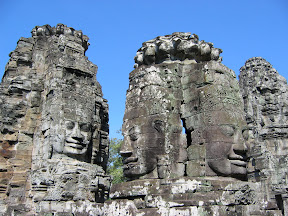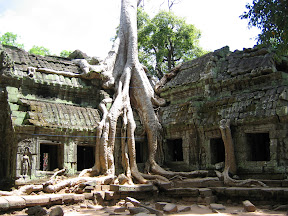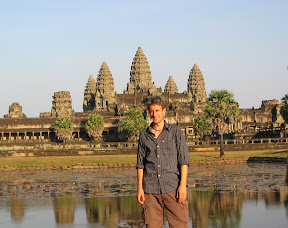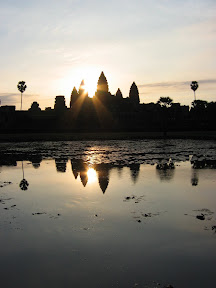The Temples of Angkor
Thursday, February 23rd, 20062/21-23/06
I’m not sure where to start in explaining the experience of Angkor. This area was once the capital of one of the world’s most powerful kingdom, the Khmers. The Angkor region alone boasts 300 temples and historic sites. To see them all would take weeks and to appreciate them on anything other than a surface level would require several more years of poring over Buddhist, Hindu, and archaeological texts.
It’s comical that some claim that the French “discovered” Angkor in the 19th century. How could you lose a capital that once had a population of over a million people. Of course this ethnocentric western view implicitly shows how eastern sites should be “found” by the west to be understood at all. It’s ridiculous.
It’s hard to say what impacted me the most. At first I suppose it’s the intricacy of the grounds; from the carvings up to the actual building designs. I was constantly asking myself how such a grand undertaking could be completed within the time span they had, roughly 150 years. My logistics side kept asking how much labor was required, where was the quarry, and who was the financier? It truly rivals the pyramids in scope.
Louise and I were always remarking about the pleasing differences in the temples. I would arrive at another temple thinking, “Oh great, another old temple,” only to find myself swept up in the subtle uniqueness of the new surroundings. The overgrown trees of some temples, the circular motif where the square usually prevails, or temples that sought to meld Buddhism and Hinduism all gave a fresh spin on what could all begin to look the same if you got lazy.
The crown jewel of Angkor is without a doubt Angkor Wat. Its scale is astounding, and its massive size give the wanderer the ability to strike out on your own, to sidestep the crowds and tour groups in the galleries and terraces to find your quiet little corner of the past. You should really see this place twice. At sunset and sunrise. And make sure to eavesdrop on the tours being given that explain the beautifully restore reliefs that stretch around the building perimeter depicting mythic battles, the history of Khmer kings, heaven and hell, and the best: the churning of the sea of milk, where the universe is rotated around a holy mountain by the masses and gods pulling a giant 5-headed serpent. Incredible.
In terms of logistics, Angkor is easy but more expensive compared to Thailand. We hired Mr. Pisith, our kind, soft-spoken Tuk-Tuk driver. To really do Angkor justice you should buy the 3-day pass for $40 US and hire a tuk-tuk. Pisith charged $17.50 per person for all three days. We tipped him well. It’s a huge area, and biking it as many do would be really hot. Tuk-tuk was the way to go.
I flew back to Bangkok on the evening of the 23rd. Louise and I had to end our week-long travel streak as I ended my S.E. Asian travel (this round), and prepared to enter China.










